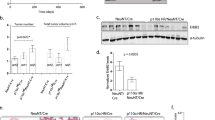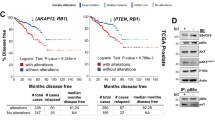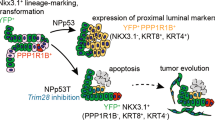Abstract
Phospholipase C-γ (PLCγ) has been implicated in tumor cell motility required for invasiveness and metastasis. Diminished tumor dissemination has been demonstrated in xenograft models, but studies in naturally-occurring tumors are lacking, having been limited by the timing of the interventions. Therefore, we generated mice that express a doxycycline (DOX)-inducible dominant-negative fragment of PLCγ, PLCz; this approach avoids the in utero lethality caused by the absence of PLCγ. As we targeted two de novo-occurring carcinomas of the mammary (MMTV-driven polyoma middle T antigen model, PyVmT) and prostate (TRAMP model) glands, we limited expression to these epithelial cells by driving DOX transactivator from the prostatein C3 promoter. This avoids the confounding variable of potentially abrogating motility in stromal and endothelial cells. These mice developed normally in the presence of DOX, except for limited mammary development if treated before 6 weeks and immaturity of the prostate gland if treated before 2 weeks of age. DOX-mediated induction of PLCz from age 8 to 16 weeks in PyVmT mice decreased the number of lung metastases by >10-fold (P<0.06) without a detectable effect on in situ tumor cell proliferation or tumor size. Lung metastases were also significantly decreased in the TRAMP model in which the mice expressed the PLCz fragment (P<0.05). DOX treatment itself had no effect on tumor size or metastasis in control mice, nor did it affect tumor dissemination in nontransgenic littermates. In conclusion, abrogation of the PLCγ signaling pathway can limit the metastatic potential of carcinomas.
This is a preview of subscription content, access via your institution
Access options
Subscribe to this journal
Receive 50 print issues and online access
$259.00 per year
only $5.18 per issue
Buy this article
- Purchase on Springer Link
- Instant access to full article PDF
Prices may be subject to local taxes which are calculated during checkout




Similar content being viewed by others
References
Bodnar RJ, Yates CC, Wells A . (2006). IP-10 blocks vascular endothelial growth factor-induced endothelial cell motility and tube formation via inhibition of calpain. Circ Res 98: 617–625.
Bornfeldt KE, Raines EW, Nakano T, Graves LM, Krebs EG, Ross R . (1994). Insulin-like growth factor-I and platelet-derived growth factor-BB induce directed migration of human arterial smooth muscle cells via signaling pathways that are distinct from those of proliferation. J Clin Invest 93: 1266–1274.
Carpenter G . (2000). The EGF receptor: a nexus for trafficking and signaling. Bioessays 22: 697–707.
Carpenter G, Ji Q . (1999). Phospholipase C-gamma as a signal-transducing element. Exp Cell Res 253: 15–24.
Chen P, Gupta K, Wells A . (1994a). Cell movement elicited by epidermal growth factor receptor requires kinase and autophosphorylation but is separable from mitogenesis. J Cell Biol 124: 547–555.
Chen P, Xie H, Sekar MC, Gupta K, Wells A . (1994b). Epidermal growth factor receptor-mediated cell motility: phospholipase C activity is required, but mitogen-activated protein kinase activity is not sufficient for induced cell movement. J Cell Biol 127: 847–857.
Chen P, Xie H, Wells A . (1996). Mitogenic signaling from the egf receptor is attenuated by a phospholipase C-gamma/protein kinase C feedback mechanism. Mol Biol Cell 7: 871–881.
Claessens F, Celis L, Peeters B, Heyns W, Verhoeven G, Rombauts W . (1989). Functional characterization of an androgen response element in the first intron of the C3(1) gene of prostatic binding protein. Biochem Biophys Res Commun 164: 833–840.
Dittman T, Husemann A, Schewe Y, Hofer JR, Niggemann B, Zanker KS et al. (2002). Induction of cancer cell migration by epidermal growth factor is initiated by specific phosphorylation of tyrosine 1248 of c-erbB-2 receptor via EGFR. FASEB J 16: 1823–1825.
Fidler IJ . (2003). The pathogenesis of cancer metastasis: the ‘seed and soil’ hypothesis revisited. Nat Rev Cancer 3: 453–458.
Gingrich JR, Barrios RJ, Kattan MW, Nahm HS, Finegold MJ, Greenberg NM . (1997). Androgen-independent prostate cancer progression in the TRAMP model. Cancer Res 57: 4687–4691.
Gingrich JR, Barrios RJ, Morton RA, Boyce BF, DeMayo FJ, Finegold MJ et al. (1996). Metastatic prostate cancer in a transgenic mouse. Cancer Res 56: 4096–4102.
Glading A, Chang P, Lauffenburger DA, Wells A . (2000). Epidermal growth factor receptor activation of calpain is required for fibroblast motility and occurs via an ERK/MAP kinase signaling pathway. J Biol Chem 275: 2390–2398.
Gossen M, Freundlieb S, Bender G, Muller G, Hillen W, Bujard H . (1995). Transcriptional activation by tetracyclines in mammalian cells. Science 268: 1766–1769.
Guy CT, Webster MA, Schaller M, Parsons TJ, Cardiff RD, Muller WJ . (1992). Expression of the neu protooncogene in the mammary epithelium of transgenic mice induces metastatic disease. Proc Natl Acad Sci USA 89: 10578–10582.
Hofmann A, Nolan GP, Blau HM . (1996). Rapid retroviral delivery of tetracycline-inducible genes in a single autoregulatory cassette. Proc Natl Acad Sci USA 93: 5185–5190.
Homma Y, Takenawa T . (1992). Inhibitory effect of src homology (SH) 2/SH3 fragments of phospholipase C-gamma on the catalytic activity of phospholipase C isoforms. Identification of a novel phospholipase C inhibitor region. J Biol Chem 267: 21844–21849.
Iwabu A, Smith K, Allen FD, Lauffenburger DA, Wells A . (2004). Epidermal growth factor induces fibroblast contractility and motility via a protein kinase C delta-dependent pathway. J Biol Chem 279: 14551–14560.
Jakobsson PA, Eneroth CM, Killander D, Moberger G, Martensson B . (1973). Histologic classification and grading of malignancy in carcinoma of the larynx. Acta Radiol Ther Phys Biol 12: 1–8.
Ji Q-S, Ermini S, Baulida J, Sun F-L, Carpenter G . (1998a). Epidermal growth factor signaling and mitogenesis in Plcg1 null mouse embryonic fibroblasts. Mol Biol Cell 9: 749–757.
Ji QS, Ermini S, Baulida J, Sun FL, Carpenter G . (1998b). Epidermal growth factor signaling and mitogenesis in Plcg1 null mouse embryonic fibroblasts. Mol Biol Cell 9: 749–757.
Jones NP, Peak J, Brader S, Eccles SA, Katan M . (2005). PLCgamma1 is essential for early events in integrin signalling required for cell motility. J Cell Sci 118: 2695–2706.
Kassis J, Lauffenburger DA, Turner T, Wells A . (2001). Tumor invasion as dysregulated cell motility. Semin Cancer Biol 11: 105–117.
Kassis J, Moellinger J, Lo H, Greenberg NM, Kim HG, Wells A . (1999). A role for phospholipase C-gamma-mediated signaling in tumor cell invasion. Clin Cancer Res 5: 2251–2260.
Kundra V, Escobedo JA, Kazlauskas A, Kim HK, Rhee SG, Williams LT et al. (1994). Regulation of chemotaxis by the platelet-derived growth factor receptor-beta. Nature 367: 474–476.
Maroulakou IG, Anver M, Garrett L, Green JE . (1994). Prostate and mammary adenocarcinoma in transgenic mice carrying a rat C3(1) simian virus 40 large tumor antigen fusion gene. Proc Natl Acad Sci USA 91: 11236–11240.
Mouneimne G, Soon L, DesMarais V, Sidani M, Song X, Yip SC et al. (2004). Phospholipase C and cofilin are required for carcinoma cell directionality in response to EGF stimulation. J Cell Biol 166: 697–708.
Muraoka RS, Dumont N, Ritter CA, Dugger TC, Brantley DM, Chen J et al. (2002). Blockade of TGF-beta inhibits mammary tumor cell viability, migration, and metastases. J Clin Invest 109: 1551–1559.
Price JT, Tiganis T, Agarwal A, Djakiew D, Thompson EW . (1999). Epidermal growth factor promotes MDA-MB-231 breast cancer cell migration through a phosphatidylinositol 3′-kinase and phospholipase C-dependent mechanism. Cancer Res 59: 5475–5478.
Reddy CC, Wells A, Lauffenburger DA . (1996). Receptor-mediated effects on ligand availability influence relative mitogenic potencies of epidermal growth factor and transforming growth factor alpha. J Cell Physiol 166: 512–522.
Ridley AJ, Schwartz MA, Burridge K, Firtel RA, Ginsberg MH, Borisy G et al. (2003). Cell migration: integrating signals from front to back. Science 302: 1704–1709.
Tehranian A, Morris DW, Min BH, Bird DJ, Cardiff RD, Barry PA . (1996). Neoplastic transformation of prostatic and urogenital epithelium by the polyoma virus middle T gene. Am J Pathol 149: 1177–1191.
Thomas SM, Coppelli FM, Song JI, Kassis J, Gooding W, Wells A et al. (2002). Epidermal growth factor receptor-stimulated activation of phospholipase Cy-1 and its role in invasion of head and neck squamous cell carcinoma in vitro. Proc Am Assoc Cancer Res 43: 542–543.
Turner T, Epps-Fung MV, Kassis J, Wells A . (1997). Molecular inhibition of phospholipase cgamma signaling abrogates DU-145 prostate tumor cell invasion. Clin Cancer Res 3: 2275–2282.
Wang W, Goswami S, Sahai E, Wyckoff JB, Segall JE, Condeelis JS . (2005). Tumor cells caught in the act of invading: their strategy for enhanced cell motility. Trends Cell Biol 15: 138–145.
Webster MA, Martin-Soudant N, Nepveu A, Cardiff RD, Muller WJ . (1998). The induction of uterine leiomyomas and mammary tumors in transgenic mice expressing polyomavirus (PyV) large T (LT) antigen is associated with the ability of PyV LT antigen to form specific complexes with retinoblastoma and CUTL1 family members. Oncogene 16: 1963–1972.
Wells A . (2000). Tumor invasion: role of growth factor-induced cell motility. Adv Cancer Res 78: 31–101.
Wells A, Kassis J, Solava J, Turner T, Lauffenburger DA . (2002). Growth factor-induced cell motility in tumor invasion. Acta Oncologica 41: 124–130.
Xie H, Turner T, Wang MH, Singh RK, Siegal GP, Wells A . (1995). In vitro invasiveness of DU-145 human prostate carcinoma cells is modulated by EGF receptor-mediated signals. Clin Exp Metast 13: 407–419.
Acknowledgements
We thank Norman Greenberg for the gift of the TRAMP mice and Dr William Muller for the gift of the MMTV-PyV mice. Dr Peter Barry kindly provided the prostatein promoter construct. This work was supported in part by grants from the Department of Defense Congressionally Mandated Medical Research Program on Prostate and Breast Cancer and a VA Merit Award.
Author information
Authors and Affiliations
Corresponding author
Additional information
Supplementary Information accompanies the paper on the Oncogene website (http://www.nature.com/onc).
Supplementary information
Rights and permissions
About this article
Cite this article
Shepard, C., Kassis, J., Whaley, D. et al. PLCγ contributes to metastasis of in situ-occurring mammary and prostate tumors. Oncogene 26, 3020–3026 (2007). https://doi.org/10.1038/sj.onc.1210115
Received:
Revised:
Accepted:
Published:
Issue Date:
DOI: https://doi.org/10.1038/sj.onc.1210115
Keywords
This article is cited by
-
Phospholipase Cγ1 (PLCG1) overexpression is associated with tumor growth and poor survival in IDH wild-type lower-grade gliomas in adult patients
Laboratory Investigation (2022)
-
PLC-gamma-1 phosphorylation status is prognostic of metastatic risk in patients with early-stage Luminal-A and -B breast cancer subtypes
BMC Cancer (2019)
-
Required hydrophobicity of fluorescent reporters for phosphatidylinositol family of lipid enzymes
Analytical and Bioanalytical Chemistry (2017)
-
Hepatic nonparenchymal cells drive metastatic breast cancer outgrowth and partial epithelial to mesenchymal transition
Breast Cancer Research and Treatment (2014)
-
Strategies for the discovery and development of therapies for metastatic breast cancer
Nature Reviews Drug Discovery (2012)



